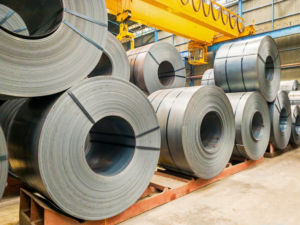
After a modest uptick in January, Chicago’s ferrous scrap metal market gained significant momentum in February, driven by rising prices and growing demand, signaling brighter days ahead. While stainless steel and aluminum scrap prices remain stagnant, copper prices are experiencing an upward trend, adding to the mixed but promising market landscape.
Chicago’s Ferrous Scrap Market
In Chicago, February saw prime grades and shred increase by $50 per gross ton, while cut grades rose by $40 and steel turning prices gained $30 compared to January’s levels. Prices have now rebounded by up to 13%, reaching levels not seen in nearly a year. This bullish market trend is driven by a combination of factors, including tight scrap metal supply, improved demand, and rising Hot Rolled Coil (HRC) prices, which have stabilized above $700 per short ton, reaching their highest level since June. Additionally, logistical constraints from the Illinois River closure, strengthened export demand, and uncertainty surrounding potential tariffs have all contributed to the market’s positive price momentum.
prime grades and shred increase by $50 per gross ton, while cut grades rose by $40 and steel turning prices gained $30 compared to January’s levels. Prices have now rebounded by up to 13%, reaching levels not seen in nearly a year. This bullish market trend is driven by a combination of factors, including tight scrap metal supply, improved demand, and rising Hot Rolled Coil (HRC) prices, which have stabilized above $700 per short ton, reaching their highest level since June. Additionally, logistical constraints from the Illinois River closure, strengthened export demand, and uncertainty surrounding potential tariffs have all contributed to the market’s positive price momentum.
Domestic demand is also on the rise, bolstered by a sharp rebound in U.S. deep-sea cargo prices to Turkey. The interplay of these factors—logistical challenges, supply constraints, rising demand, and tariff-related uncertainty—has created a strong pricing environment, setting the stage for continued market movement in the months ahead.
“The past year has been challenging, but February’s price increases offer some relief,” states Lou Plucinski, President. “Tight supply, rising demand, and a stronger HRC market are finally creating a more optimistic outlook.”
Navigating Tariff Uncertainty
 The potential implementation of tariffs will disrupt supply chains, shift trade flows, and have already introduced volatility into the market.
The potential implementation of tariffs will disrupt supply chains, shift trade flows, and have already introduced volatility into the market.
President Donald Trump’s proposed 25% tariff on Canadian and Mexican imports, initially set to take effect on February 4, has been suspended for 30 days, leaving the domestic ferrous scrap market in a state of uncertainty. Under the United States-Mexico-Canada Agreement (USMCA), the U.S. is a net exporter of recycled materials, including secondary scrap grades like No 2 Heavy Melt, Shred, copper, brass, stainless steel, and secondary aluminum. Each year, an estimated $8 billion in recycled materials crosses the U.S.-Canada border, and $3.3 billion crosses the U.S.-Mexico border. Despite being a net exporter, the U.S. still imports approximately 150,000 tons of prime scrap monthly, including No 1 Busheling and No 1 Bundles.
On February 10, President Trump announced a 25% tariff on steel and aluminum imports. In the short term, scrap prices are expected to rise as domestic mills increase purchases to compensate for reduced imports. However, the long-term impact remains uncertain and will depend on whether the tariffs remain in place, exemptions are granted, or alternative sourcing strategies emerge. Canada, Mexico, Germany, and Asia are anticipated to be most affected by these duties.
Steel and Aluminum Exports to the U.S.

In the short term, these tariffs will help boost prices as domestic mills increase their demand to offset the reduced imports. The long term effects depend on whether or not the tariffs hold or if any exemptions are granted. If prices rise too much, demand could potentially decline, offsetting any gains in the market.
Chicago’s Non-Ferrous Scrap Market
As February begins, the stainless steel and nickel market remains stagnant, with prices trading sideways. This is largely due to oversupply from Indonesia, falling nickel prices, steady demand, and rising inventory levels. Nickel prices hit a four-year low in early January 2025, as supply outpaces demand, especially from the electric vehicle sector, which has not grown as expected. Despite some production cuts, the market remains imbalanced.
 In contrast, copper prices are rising, supported by a weaker U.S. dollar despite trade tensions. The weaker dollar makes copper more affordable for foreign buyers, boosting prices. Meanwhile, aluminum scrap prices have softened, reflecting broader declines in the aluminum market, despite U.S. tariffs on imports from Canada, Mexico, and China. While these tariffs have led to price declines, they may eventually increase demand for domestically sourced aluminum scrap, potentially supporting future price gains.
In contrast, copper prices are rising, supported by a weaker U.S. dollar despite trade tensions. The weaker dollar makes copper more affordable for foreign buyers, boosting prices. Meanwhile, aluminum scrap prices have softened, reflecting broader declines in the aluminum market, despite U.S. tariffs on imports from Canada, Mexico, and China. While these tariffs have led to price declines, they may eventually increase demand for domestically sourced aluminum scrap, potentially supporting future price gains.


